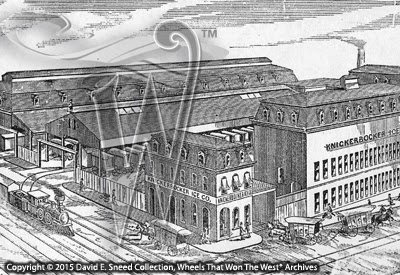The Wheels That Won The West® Collectionof early vehicle literature includes details on a number of horse drawn vehicletypes. The styles we predominantly focuson are those within the farm, freight, ranch/trail, coach, business, and military categories. Looking back over the years of articles andblogs, I realized that we haven’t covered as many examples of wagons andassociated builders that would be included in the general ‘business’ or commercialcategory. So, since many of us seem to be stuck with old man winter for a little longer, we’ll focus ona company and vehicle built to make the most of the cold.
Many will know of or perhaps remember atime when refrigeration of food was limited to the chill of a cool, flowing spring or maybeeven a sawdust insulated wooden box. Mydad grew up in the South during a time when those things were common. As a teenager, I helped clean out the oldfamily spring house (over time the silt accumulates) where they had once keptfresh milk. I also have an old ice box. It’s a simple design with a top lid and galvanizedmetal liner. At one time, blocks of ice wouldhave been placed inside to help preserve food. The designs were a precursor to modern refrigerators which didn’tbecome prevalent until the 1920’s and later. I still remember my grandmother asking me to go to her back porch andget food from her “ice box.” It was anelectric freezer but the term was so rooted in her past that she almost neverreferred to it in any other way.
Having true ‘ice boxes’ in a home seemsto have become relatively commonplace in America by 1900, with associated iceproviders making regular deliveries to homes and businesses. One of the industry legends, theKnickerbocker Ice Company of Philadelphia, harvested, stored, and delivered iceduring the 19th and early 20th centuries.
 |
| This historic cut shows a portion of thePhiladelphia workshops of the Knickerbocker Ice Company. |
Knickerbocker had a long history,apparently dating to as early as the mid-1800’s. The business was incorporated in May of 1864and appears to have eventually come under control of the American Ice Companyof New Jersey.† In the mid-1890’s, thecompany was reported to have $2,000,000 of invested capital. In similarly impressive numbers, the firmmaintained storage capacity for 1,000,000 tons of ice. The product was delivered to customersthroughout Pennsylvania, New Jersey, and Maine with large wholesale clientsbeing dealers, brewers, and packing houses. So strong was the business that, distribution of ice to customers inPhiladelphia, alone, was said to have required over 500 wagons and 1,200 horsesand mules. It was a demanding operationmaintained by massive workshops ran by the company. The plant in Philadelphia was manned byapproximately 125 employees and included multiple machine shops, a foundry, toolworks, harness making shop, horse shoeing shop, and a wagon manufactory. The Ice Wagons built by Knickerbocker capitalizedon bright graphics and attractive designs. They were sold throughout the U.S.; from Texas to California, Marylandto Georgia, and Illinois to Florida.
 |
| This rare illustration from the Wheels That WonThe West® Archives portrays a scene from the Paint shop of the KnickerbockerWagon factory. |
Among the strongest vehicles produced byKnickerbocker was a 2-horse supply wagon. It was impressively rated to haul up to 4 tons of ice and gear whileweighing in at just over 2700 pounds. Inthe same 1889 catalog, a hand-painted vehicle with murals, labeled as a“Picture Wagon,” was set on heavy platform springs and designed to carry up to3 tons. Overall, the two-horse designsgenerally ranged from 3,000 to 8,000 pound capacities. Knickerbocker’s one horse ice wagons included an equally wide variety ofdesigns with hauling capacities starting at 1500 pounds and extending up to 3500pounds. The firm even made two-wheeledice carts with a capacity of 1,000 pounds.
 |
| An early promotional image showing a 2-horseKnickerbocker Ice Wagon with a capacity of 4,500 pounds. |
While Knickerbocker claimed to be thelargest producer of wagons, tools, and machinery for moving ice*, it was farfrom the only builder of Ice Wagons. Anumber of major manufacturers included these designs in their offerings. At the turn of the 20th century, thefamed Studebaker Wagon Company was building Ice Wagons with steel axle sizesranging from 1 3/4” to 2 5/8”. The dimensions were typically related toweight capacities of a particular design. Wholesale pricing for complete vehicles could range from just over $400to almost $700; over double and triple of what a farm wagon would have sold forat the time.
Today, original ice wagons in goodcondition can command a much higher tag. No longer used in the same way, they are cherished for their artfuldesign, timeframe of service, regional history, maker brand, and the memoriesthey evoke. † “Moodys Manual of Railroad and Corporation Securities,” 1921, p. 61-64, Industrials section
* “The City of Philadelphia as it Appears in the Year 1894,” p. 205
Please Note: As with each of our blog writings, all imagery and text is copyrighted and may not be broadcast, published, rewritten, or redistributed without prior written permission from David E. Sneed, Wheels That Won The West® Archives.